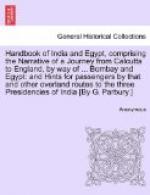In conclusion one may briefly record what the Bhandaris thought of the presence of a European at their sacred rite. Some feared him as one that contemplated the imposition of a new tax; others viewed him askance as a doctor from the Hospital despatched by higher authority to put an end to the ceremony; and yet others,—the larger number insooth,—deemed that here at last was a Saheb who had found physic a failure and had learned that the Mother alone has power to allay grievous sickness.
XI.
SCENES IN BOMBAY.
A MUSULMAN HOLIDAY.
Nearly all the Mahomedan inhabitants of Bombay observe as a general picnic day the last Wednesday of the month of ‘Safar’ which is known as ’Akhiri Char Shamba’ or ‘Chela Budh’; for on this day the Prophet, convalescent after a severe illness, hied him to a pleasance on the outskirts of Mecca. During the greater portion of the previous night the women of the house are astir, preparing sweetmeats and salt cakes, tinging their hands with henna, bathing and donning new clothes and ornaments; and when morning comes, all Mahomedans, rich and poor, set forth for the open grounds of Malabar Hill, Mahalakshmi, Mahim or Bandora, the Victoria Gardens, or the ancient shrine of Mama Hajiyani (Mother Pilgrim) which crowns the north end of the Hornby Vellard. To the Victoria Gardens the tram cars bring hundreds of holiday-makers, most of whom remain in the outer or free zone of the gardens and help to illumine its grass plots and shady paths with the green, blue, pink and yellow glories of their silk attire. Here a group of men and women are enjoying a cold luncheon; there a small party of Memons are discussing affairs over their ‘bidis’ while on all sides are children playing with the paper toys, rattles and tin wheels which the hawkers offer at such seasons of merry-making. Coal-black Africans, ruddy Pathans and yellow Bukharans squat on the open turf to the west of the Victoria and Albert Museum; Mughals in long loose coats and white arch-fronted turbans wander about smoking cigars and chatting volubly, while Bombay Memons in gold turbans or gold-brocade skullcaps, embroidered waistcoats and long white shirts stand on guard over their romping children.
* * * * *
The road leading from Mahalakshmi to the shrine of Mama Hajiyani is particularly gay, and the Vellard is lined throughout its entire length with carriages full of men, women and children in their finest attire; while under the palms on the east side of the road the hum of a great crowd is broken from time to time by the cry of the sellers of sweets, toasted grain, parched pistachio nuts and salted almonds, or by the chink of the coffee seller’s cups. A happy, orderly crowd it is, free from all signs of quarrelling and excess, packed more densely than usual around the shrine of Mama Hajiyani, where every little vacant space is monopolised by merry-go-rounds and by the




